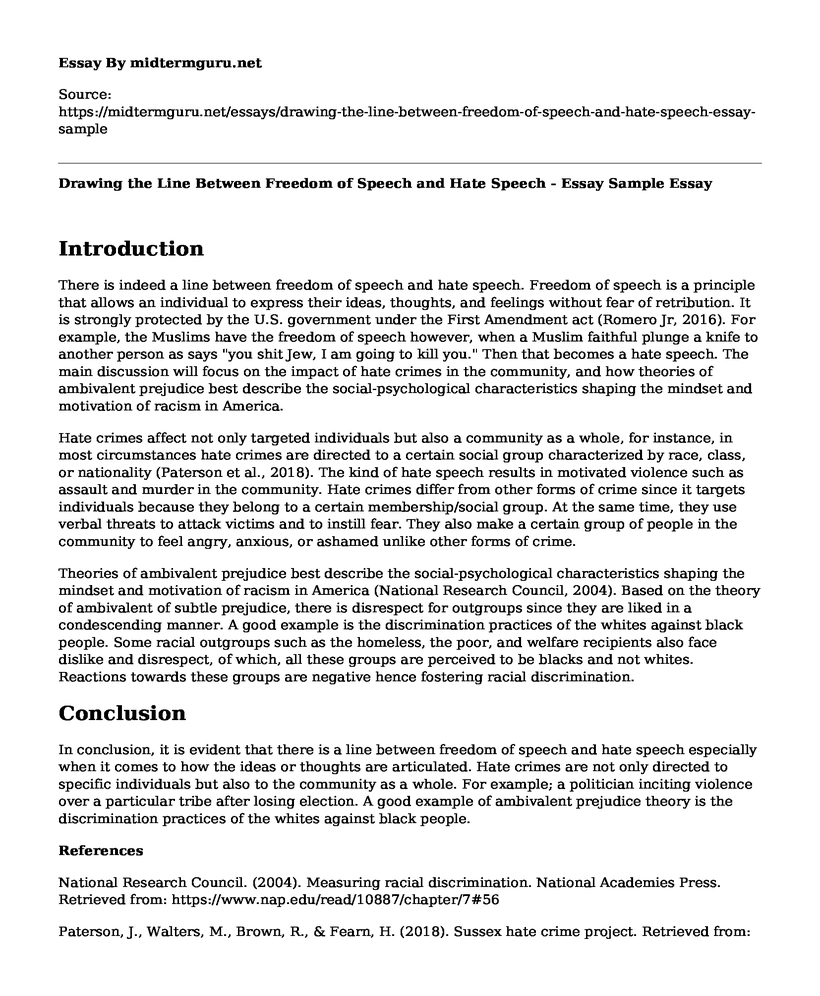Introduction
There is indeed a line between freedom of speech and hate speech. Freedom of speech is a principle that allows an individual to express their ideas, thoughts, and feelings without fear of retribution. It is strongly protected by the U.S. government under the First Amendment act (Romero Jr, 2016). For example, the Muslims have the freedom of speech however, when a Muslim faithful plunge a knife to another person as says "you shit Jew, I am going to kill you." Then that becomes a hate speech. The main discussion will focus on the impact of hate crimes in the community, and how theories of ambivalent prejudice best describe the social-psychological characteristics shaping the mindset and motivation of racism in America.
Hate crimes affect not only targeted individuals but also a community as a whole, for instance, in most circumstances hate crimes are directed to a certain social group characterized by race, class, or nationality (Paterson et al., 2018). The kind of hate speech results in motivated violence such as assault and murder in the community. Hate crimes differ from other forms of crime since it targets individuals because they belong to a certain membership/social group. At the same time, they use verbal threats to attack victims and to instill fear. They also make a certain group of people in the community to feel angry, anxious, or ashamed unlike other forms of crime.
Theories of ambivalent prejudice best describe the social-psychological characteristics shaping the mindset and motivation of racism in America (National Research Council, 2004). Based on the theory of ambivalent of subtle prejudice, there is disrespect for outgroups since they are liked in a condescending manner. A good example is the discrimination practices of the whites against black people. Some racial outgroups such as the homeless, the poor, and welfare recipients also face dislike and disrespect, of which, all these groups are perceived to be blacks and not whites. Reactions towards these groups are negative hence fostering racial discrimination.
Conclusion
In conclusion, it is evident that there is a line between freedom of speech and hate speech especially when it comes to how the ideas or thoughts are articulated. Hate crimes are not only directed to specific individuals but also to the community as a whole. For example; a politician inciting violence over a particular tribe after losing election. A good example of ambivalent prejudice theory is the discrimination practices of the whites against black people.
References
National Research Council. (2004). Measuring racial discrimination. National Academies Press. Retrieved from: https://www.nap.edu/read/10887/chapter/7#56
Paterson, J., Walters, M., Brown, R., & Fearn, H. (2018). Sussex hate crime project. Retrieved from: https://research.tees.ac.uk/ws/files/4175549/621941.pdf
Romero Jr, A. (2016). The line between free speech and hate speech. Retrieved from: file:///C:/Users/User/Downloads/918.HateSpeech.pdf
Cite this page
Drawing the Line Between Freedom of Speech and Hate Speech - Essay Sample. (2023, Jan 31). Retrieved from https://midtermguru.com/essays/drawing-the-line-between-freedom-of-speech-and-hate-speech-essay-sample
If you are the original author of this essay and no longer wish to have it published on the midtermguru.com website, please click below to request its removal:
- Paper Example on Delinquency Among the Minority Races in the United States
- Paper Example on Gender and Representation
- Research Paper on Displacement
- Exploring the Moral Debate on Suicide - Research Paper
- Equal and Fair Treatment: Cornerstone of the Workplace - Essay Sample
- Attraction and Interpersonal Relationships: Exploring Social Factors - Essay Sample
- Mail Etiquette: Understanding Tone and Proofreading Before Sending - Essay Sample







